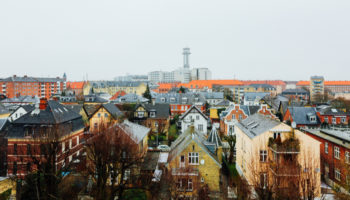When you’re travelling, especially if you’re short on time, you really want to make the most of your destination so you go home feeling like you haven’t missed anything and that you’ve really got a feel for the place. Sure, it can be a challenge, so we’ve worked to pare down all there is to do in Barcelona to 10 of the musts. If you can’t get to them all, you can always come back.
Discover the city on foot
Barcelona is a big city, but it’s the perfect size to discover on foot. Spend a day away from the metro and the tourist bus, and take your time strolling around and stopping to recharge with some of the city’s great gastronomic options. If you’re in the mood for visiting some of the most impressive buildings and parks, you’ll want to see all the Parc de la Ciutadella has to offer as well as the Parc de Joan Miró, and the Montjuïc castle, but there’s also a Barcelona you won’t find in guidebooks. Get off the beaten path and head up to Horta, get to know the charm of the Sant Andreu district, see a lesser-known side of the Eixample and take in breathtaking panoramic views.
If your legs are more up to the task than your feet, you can also see the city by bicycle. Of the numerous ones around town, we’ve weeded out 10 routes in the city and surrounding areas for you to discover Barcelona while you pedal, whether you’re a lifelong cyclist or still wobbling about without those extra wheels in the back.
And if you’re a runner and won’t let yourself miss a day even during your holidays, we’ve got an option for you as well.
Explore Gaudí and modernisme
Without a doubt, one of Barcelona’s top attractions for tourists (as well as for those who live here) is admiring the city’s modernista architecture, and the works of Antoni Gaudí in particular. Just walking around you’ll come across various examples of Gaudí’s work throughout the city, be they civil or religious buildings. The most famous are the Sagrada Família, impressive both outside and in; Park Güell, a space that’s out of a fairy tale and emulates an English garden city; and La Pedrera. But don’t miss the opportunity to visit other Gaudí buildings that sometimes occupy smaller space in guidebooks, such as Palau Güell, Casa Batlló, Torre Bellesguard, Casa Vicens and (if you have time to venture a bit outside Barcelona) the crypt of the Colònia Güell, in Santa Coloma de Cervelló.
But Gaudí wasn’t the only modernista architect who left his mark on Barcelona. Also worth a visit are Casa Amatller and the Palau de la Música, works by Puig I Cadafalch; Casa Lleó Morera, designed by Domènech i Muntaner; and Casa de les Terrades. Another example is the Hospital de la Santa Creu i Sant Pau, a World Heritage Site and whose gardens are an oasis in the bustle of the city. Book your tickets now!
Hit a high note in concert
Barcelona has its fair share of live music venues, such as Razzmatazz and Apolo, but the city boasts some wonderful concert halls as well. The Gran Teatre del Liceu is a survivor in splendor, decorated with gold leaf, plush red carpets and ornate carvings. Don’t shy away from checking out the programme, as tickets are not always as expensive as you might think, and it’s a space that’s definitely worth a visit. Then there’s L’Auditori, a sleek space with a capacity for 2,400 concert-goers, and not just fans of classical – they also host jazz and world music performances, among others. The Palau de la Música Catalana is celebrated for its modernist architecture and for the sheer number of concerts it hosts. Barcelona is also home to several international music festivals, including Primavera Sound, the Festival Internacional de Jazz de Barcelona, Sónar and Cruïlla, among others.
Picture the city of Picasso’s youth
Picasso’s Barcelona, where he spent his early years, was beautiful and vibrant. Follow the footsteps of the artistic genius as you visit the landmarks that shaped his youth. Walk down C/Reina Cristina and then cross over to number 3 on C/Mercè to see where his family lived, though the building was later destroyed. If you need to make a stop along the way, head to Els 4 Gats, where artists, including Picasso and Salvador Dali, gathered at the time to chat, eat dinner and have meetings about art. Finally, visit the Museu Picasso itself, a gallery that houses works from Picasso’s formative years. Book your tickets now!
Fill up on tapas, pintxos and vermouth
Pintxos, in essence, are Basque tapas – plates of bite-sized goodies served atop a piece of bread – and they’re also a culinary trend in Barcelona. Tradition calls for you to pick at the food with toothpicks, and at the end of the night you will be charged for the number of toothpicks that you have used. One of the best places to give them a try is Euskal Etxea, where you can get stuck in to ham empanadillas (a type of pie), pintxos made of chicken tempura with saffron mayonnaise, melted provolone with mango and ham, or a mini-brochette of pork. But lest you forget, there are many more pintxos places in town as well.
But if what you really want are tapas, your options multiply – traditional, elaborate, places where patatas bravas are the stars of the menu, and tapas bars to go to if a good beer to wash them down is a priority. Some of the essentials are Quimet i Quimet, La Esquinica or El Jabalí.
And of course, everything tastes better accompanied by a good vermouth. The weekends (or when you’re on holiday) are ideal because there’s more time to do a vermouth crawl, as is the custom, with a bite to eat as you sample the various types. But really any time is a good time to try the vermouth of the house in classic bodegas such as Bar Calders, La Pepita and Bar Electricitat. Book your tickets now!
Climb up the magical Montjuïc
Montjuïc mountain is the perfect place for a leafy stroll with great views, but it does take a bit of legwork to get up there, so it’s less populated by tourists. But don’t let that deter you. Aside from the natural surroundings and spectacular vistas, you’ll find buildings from the 1992 Olympic Games, including the Palau Sant Jordi and the telecommunications tower designed by Santiago Calatrava. If you’re feeling full of beans and you get to the top of the hill, you can check out the Olympic stadium and the Jardi Botànic. Plaça Espanya, at the foot of Montjuïc, is the most common access point to the mountain, and where you can also visit the Pavelló Mies van der Rohe and the CaixaForum cultural centre.
Walk through the Laribal gardens, designed by French landscape architect Jean-Claude Nicolas Forestier; visit the Tres Pins nursery, where plants are grown for gardens and municipal parks in the city; and tip your hat to the bronze statue of the Italian poet Dante Alighieri in the square of the same name. Book your tickets now!
Walk on the arty side
In Barcelona, taking a walk in the park is not only a way to relax, it can also lead you to discover some great art. Get up and get out for a walk around the lush gardens of the Teatre Grec and then head over to the Fundació Joan Miró, one of the largest museums in the world and home to a collection of over 225 paintings, 150 sculptures and graphic pieces by the Spanish surrealist painter, along with a number of works by his contemporaries.
Listing all the museums and art galleries in the city would take quite a bit of time, but one of the jewels is the MNAC (Museu Nacional d’Art de Catalunya), with pieces that represent Catalan art from the Romanesque period to the mid-20th century.
If smaller rooms are more your speed, stop in to the Palau Robert – it’s free in, has some great exhibitions and the building itself is worth a gander. Also pay a visit to some of the smaller but influental galleries throughout the city, some of the most prestigious of which are ADN, Joan Prats, Galeria 3 Punts and Toni Tàpies. Book yout tickets now!
Revel in the Raval
Like Paris, Barcelona also has a literary flavour. Many a writer has been inspired by the lower Raval, which was once called the ‘Barrio Chino’, a name coined by an American journalist due to its underworld feel in the 1920s. Haunted by drifters and prostitutes (and, more recently, hipsters and their ilk), the seedy ghetto forms a strangely glamorous setting for Jean Genet’s existential novel The Thief’s Journal (1949) and provides the backdrop of the civil war novel The Palace (1962) by Nobel prize-winner Claude Simon and The Margin by André Pieyre de Mandiargues (1967), which was made into a film.
But the Raval is so much more. It’s a place where local businesses thrive, including shops like Les Topettes, Chandal and Fusta’m; it’s also about urban culture, music and good food, the likes of which you’ll find in Bar Kasparo, Lo de Flor and Dos Palillos.
The Raval is also where you need to go to get some of the city’s essential culture nourishment, including the CCCB (Barcelona’s contemporary culture centre, which hosts exhibitions, conferences and more), the MACBA (the city’s contemporary art museum), the Biblioteca de Catalunya (library) and the refurbished Filmoteca arthouse cinema. Book your tickets now!
Get to know the city’s history
When visiting a new city, it’s always good to learn a bit about its history in order to understand its architecture, its art, what makes it tick, and something of the character of its people. As an international city, Barcelona is full of diverse cultures and heritages, and with every step you take through its streets, you’ll stumble upon some of its history.
You can get an idea of this historical wealth at the Museu d’Historia de Barcelona (MUHBA) where the historical heritage of the city is preserved and put on display in the MUHBA’s various locations (most importantly those of the Plaça del Rei, the Call, the Temple d’August, and Refugi 307), the brand-new Born Centre Cultural, the Columnas de Adrian (Pillars of Hadrian), the royal shipyards of the Museu Maritím, the various shelters that were built to survive the Civil War, the modernist Illa de la Discòrdia (Block of Discord, noted for its four modernist buildings on Passeig de Gràcia), and the Fossar de les Moreres, which was once one of the historical cemeteries near the Santa Maria del Mar church and is a war memorial for those who lost their lives during the siege of Barcelona (1713-1714).
Chow down fresh seafood
No one leaves Barcelona without sampling the seafood. The city toasts the fine and luxurious Galician restaurant Rias de Galicia in Poble-sec, as well as Cachitos in the Eixample, for their fantastic assortment of seafood. Cal Pep in the Born is known for its trifásico, a mélange of fried whitebait, squid rings and shrimps, and exquisite little tallarines (wedge clams). The Barceloneta restaurants La Mar Salada and Can Solé display a spectacular haul of fresh seafood every day, which is likely to tempt you if you’re piscatorially inclined. Book your tickets now!





